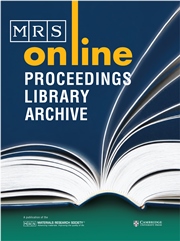No CrossRef data available.
Article contents
Persistent Photoconductivity in Bulk Strontium Titanate
Published online by Cambridge University Press: 19 August 2014
Abstract
Strontium titanate (SrTiO3) has novel properties, including a large temperature-dependent dielectric constant, and can be doped to make it metallic or even superconducting. The origin of conductivity observed at the SrTiO3/LaAlO3 interface is a topic of intense debate. In the present work, bulk single crystal SrTiO3 samples were heated at 1200°C, with the goal of producing cation vacancies. These thermally treated samples exhibited persistent photoconductivity (PPC) at room temperature. Upon exposure to sub-band-gap light (>2.9 eV), the free-electron density increases by over two orders of magnitude. This enhanced conductivity persists in the dark, at room temperature, for several days with essentially no decay. Light excites an electron from the vacancy to the conduction band, where it remains, due to a large recapture barrier. These observations highlight the importance of defects in determining the electrical properties of oxides and may point toward novel applications.
Keywords
Information
- Type
- Articles
- Information
- Copyright
- Copyright © Materials Research Society 2014

